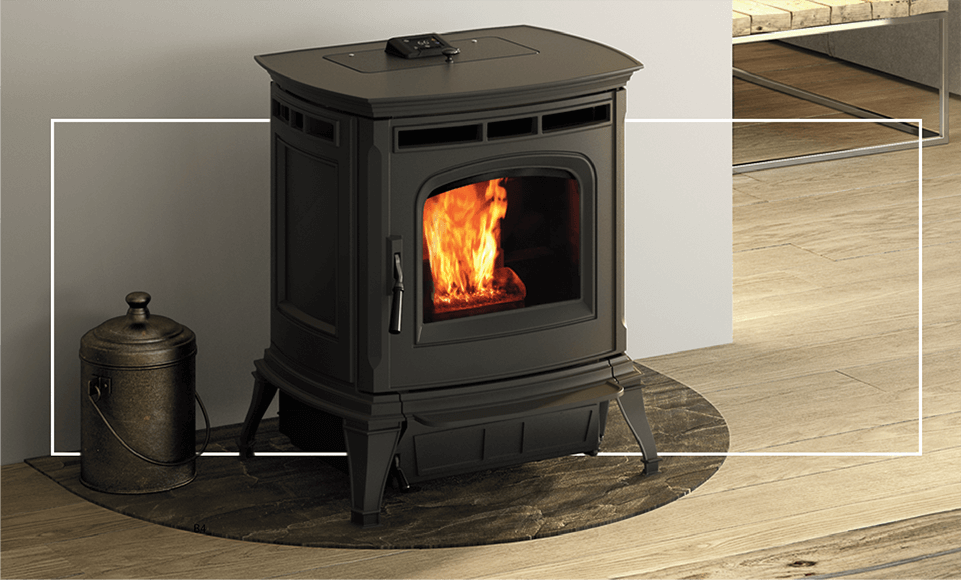We often get asked, “What’s the best way to store my wood pellets?” In this post, we’ll talk about how you can efficiently and effectively store wood pellets all year long for your pellet stove. We’ll explain storage methods, what type of conditions they require and options for large homes as well as those with less room. We’ll provide tips we’ve accumulated on storing wood pellets and throw in important FAQs on some of our best technology.
What are Wood Pellets?
Wood pellets, a biomass fuel made of sawdust and scrap wood, are derived from logging and manufacturing, forest debris and crop waste. This organic matter is dried and pressed into pellets that deliver a long-lasting, clean-burning heat.
The Benefits
The benefits of a wood pellet heating stove are impressive. There are various ways you can save money when switching to a pellet stove as a primary or secondary heating source:
- Buy in bulk: You can purchase pellets in 40-pound bags and stock up for the whole season. They are readily available in the summer, sometimes even at a reduced cost. This post will fill you in on how to store them properly while you wait for winter.
- Return on investment: One ton of pellets costs $300, which allows you to fuel your pellet stove for about one-third of the winter season if you're using it as your main heating source. Compared to fuel oil, you’ll save over $3,000 in heating costs in an average winter.
- Reducing your carbon footprint: Comprised of plants, biomass “captures almost the same amount of CO2 through photosynthesis while growing as is released when biomass is burned,” according to the U.S. Energy Information Administration. This means heating with biomass is carbon neutral; every ton of pellets used instead of heating oil reduces carbon emissions by about 1.5 tons.
- A reliable and efficient alternative heat source: Providing a slow long-lasting burn, wood pellet stoves provide anywhere from 8,000 to 90,000 BTUs per hour. Additionally, the pellets themselves contain little to no moisture. A factor that lends to their 100% conversion into heat energy. In the United States, the PFI Standards Program requires pellet producers to undergo regular, third-party facility inspections and testing, ensuring pellet stove owners a reliable, quality biomass fuel.
Why Does Proper Pellet Storage Matter?
Wood pellets are typically packaged in 40-pound bags. The average homeowner will need two to three tons to heat their home annually, according to the Pellet Fuels Institute (PFI). When calculated, that’s equivalent to 100-150 bags of pellets or two to three pallets per year.
You’re probably asking yourself, What do I do with all those wood pellets? The ideal storage for wood pellet fuel is a clean, dry, air-tight plastic container. The North American pellet manufacturer Energex suggests using an FDA-approved airtight storage bucket to keep out any environmental elements such as water. When your pellets are dry and light easily, you can better control the temperature of your pellet stove.
Once your pellets get wet, they can rot, destroying their integrity. Damp and degraded, they clog up the stove’s hopper, which can result in a mechanical malfunction.
5 Tips For Storing Wood Pellets

- Store in a cool, dry space, protected from water and humidity.
- Store in the original bag, indoors, stacked on top of a cardboard-covered pallet.
- If storing wood pellets outdoors, pick high ground, away from tall trees, protected from wind and rain, and covered with a tarp.
- When stacking your pellet bags on a pallet, switch the direction of each row to prevent moisture from entering.
- Whether indoors or outdoors, store wood pellets away from heat sources such as direct sunlight, furnaces, grills, fireplaces, water heaters or any other appliance that gives off heat.
FAQS
Do wood pellets attract rodents or other pests?
Bugs are not able to survive the pellet-making process. Additionally, once the manufacturer seals the bag, insects can’t get inside. The pellets more likely to attract unwanted pests are those that contain shelled corn or other additives. However, most stove owners prefer pellets made without additives or bark.
Where should I store my extra wood pellets during the spring and summer?
In the warmer months, store leftover pellets (from an already opened bag) in an FDA-approved airtight container. Keep them away from water sources like pools or sprinklers and other heat sources to ensure they don’t self-heat. When piled together, wood pellets release heating gasses that can be ignited when reaching 195 degrees Fahrenheit or higher.
Can wood pellets be stored close to the heating stove?
No. When storing wood pellets indoors, don’t keep them too close to the stove, or any other heat source for safety reasons. As a good rule of thumb, we recommend keeping them at least three feet away from your pellet stove or insert.
Why Harman Pellet Stoves?
Dedicated to educating consumers and providing beneficial resources for the pellet stove user, Harman wants every aspect of stove ownership to be informed and positive. Our website contains educational blog posts on how wood pellet heating stoves can improve the quality of your home and life and helpful resources to ensure you’re a confident and capable pellet stove owner.
The Harman product line features technologies that make wood pellet stove heating easier. Many of our pellet stoves boast Exhaust Sensing Probe Technology (ESP), the Pellet Pro System, EASY Touch Control, Wireless Room Sensor, and Zone Heating. If you’re ready to install a wood pellet heating stove in your home, visit use our website to find a dealer near you.


